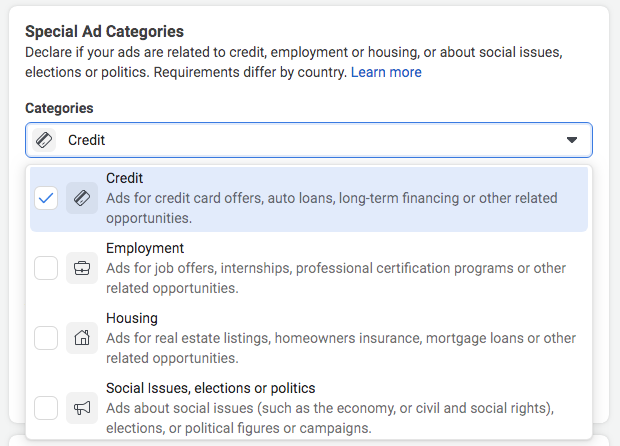
If your Facebook / Meta ad campaigns require assignment of a Special Ad Category, you no longer can target Special Ad Audiences (or their step-sister, Lookalike audiences) as of October 12, 2022. This impacts businesses offering credit cards, auto loans (i.e., any auto dealer) and long-term financing in general. It also impacts any advertiser of job offers or professional certificate programs, real estate listings, homeowners insurance, mortgage loans, and political advertisers. See the related timeline for these changes, as well as developer news & documentation.
Why is Facebook doing away with Special Ad Audiences?
The Department of Housing and Urban Development (HUD) claimed Meta’s ad platform targeting was discriminating by using personal traits it collects from Facebook users (race, color, national origin, religion, family status, gender and disability) to determine who is presented ads. This was happening even if the advertiser didn’t intend it, as ad presentation is driven by Meta machine-learning algorithms that build targeting audiences (form of Special Ad Audiences & Lookalike Audiences) based at least partially on these characteristics that are protected under the Fair Housing Act (FHA). HUD’s position was that this practice limits a person’s housing choices.
The Department of Justice (DOJ) agreed. Facebook settled, committing to stop the use of Special Ad Audiences & Lookalike Audiences for all campaigns flagged with Special Ad Category “Housing”, as well as categories “Credit”, “Employment”, and “Social issues, elections or politics”.
Is there a targeting alternative for Facebook campaigns flagged with a Special Ad Category?
Facebook’s soon defunct attempt at fairness in targeting for special ad category flagged campaigns was Special Ad Audiences, which limited or made unavailable targeting based on: age, gender, ZIP code or postal code, exclusion targeting, lookalike audiences, saved audiences, and some interests. Facebook has not been explicit in identifying a related targeting alternative for campaigns flagged with a Special Ad Category.
However, in theory an advertiser can create a Lookalike audience outside of Facebook, and upload it for targeting as a custom audience based on first party data. Such audiences should not be restricted for Facebook campaigns flagged with a Special Ad Category. To upload such data, you’ll have to agree to Facebook’s terms to confirm you have a legal basis to use the information you plan to upload. Facebook has a microsite detailing advertiser responsibilities with custom audiences related to the General Data Protection Regulation (GDPR).
How do alternative targeting solutions prevent discrimination?
How does creating a Lookalike audience outside of Facebook prevent discriminatory ad targeting? The answer is, it does not prevent it – but it may not necessarily promote it either. The data services that allow creating such Lookalike audiences outside of Facebook will most meaningfully answer this question through the specifics of their modeling algorithm (which is often a “black box”, the details of which are only known by the service provider) and the control (or lack thereof) they give advertisers in making selections for optional variables that drive such modeling.
The advertiser can help answer this question not just by being fair-minded in making selections for optional model variables, but way more importantly by the seed data they provide that drives the modeling algorithm. If advertiser first party data is diverse, the modeling algorithm will (or at least should) produce a diverse Lookalike audience.

What vendors provide such targeting solutions?
LiveRamp, Data Axle, Nielsen, Oracle, Lotame, Neustar & Experian to name a few. Such vendors provide first-party data management, identity resolution, enrichment, and distribution services. You upload first party data, enrich it from other data sources, collate identified user activity across multiple devices & offline interactions, and distribute the data to ad platforms for targeting.
These platforms can act as safe harbors for anonymizing and delivering targeting data. They take your first-party data, and that of other data sources, and where the data intersects they assign an anonymized ID that relates to each of their data panels – and coordinate integrations with ad platforms based on this anonymized ID. This is a good practice to have in effect for ad targeting relative to an ever increasing privacy regulations landscape.
Some considerations in selecting such a service:
- Is the vendor focused on this specific service offering, or are they distracted by having their fingers in many unrelated pies?
- Does the vendor’s solution over-promote use of their own data sources?
- What control does the vendor give you in building segments?
- Does the vendor’s solution promote compliance with privacy regulations?
- Has the vendor established integrations with a meaningful number of platforms that support and/or allow enhancement of your specific advertising strategies?
